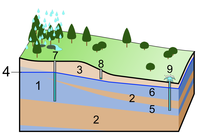
Photo from wikipedia
Abstract Iowaite with designed Mg/Fe ratios of 2.5, 3.0, 3.5, 4.0 and 5.0 was synthesized for treating both arsenate- and arsenite-spiked waters in this study. The experimental results show that… Click to show full abstract
Abstract Iowaite with designed Mg/Fe ratios of 2.5, 3.0, 3.5, 4.0 and 5.0 was synthesized for treating both arsenate- and arsenite-spiked waters in this study. The experimental results show that there is a positive correlation between the molar ratio of Fe to Mg of synthetic iowaite and its arsenic uptake capacity. The dearsenication mechanisms were investigated based on the XRD, SEM and EDX analyses of solid samples before and after reaction with arsenic-bearing solutions. When the initial solution concentration of arsenic is not higher than 7500 μg/L, anion exchange between arsenate or arsenite in solution and chloride in the interlayer regions of iowaite is the primary mechanism for arsenic removal. However, at a very high initial arsenic concentration in solution (750 mg/L), the dissolution of iowaite and subsequent formation of new minerals, such as scorodite and karibibite, are responsible for the substantial removal of arsenic from water. Iowaite is superior to other types of layered double metal hydroxides (LDHs) such as hydrotalcite and hydrocalumite in terms of water dearsenication, and therefore promising for treatment of arsenic-rich waters, either naturally occurring waters or industrial wastewaters.
Journal Title: Applied Geochemistry
Year Published: 2017
Link to full text (if available)
Share on Social Media: Sign Up to like & get
recommendations!